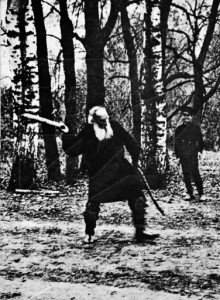Urban Legend- ghost story
Transcription
“This event happened a year after my great grandfather died. My family was over at my Grandmother’s house in order to celebrate Thanksgiving. The house is in down town Santa Ana, in a creepy old neighborhood. Think of a ghetto. For the last four year in row, the oven has broken down on Thanksgiving. Like a curse or something. When we were eating, this large ball of light shoots through kitchen and living room. Everybody just stops and is confused. People in two different rooms, the kitchen and the living room, about 12 people saw this.”
CB explains this family story to me while we were eating Wendy’s. He explains that this is story is now told whenever at family meetings. He mentions that he believes that the death of his great grandfather in the house, the ball of light, the curse of the oven each year, and the fact that the house is old is all somehow connected. He states because the house is so old, that many people have died in it over the years possibly making the house haunted. He also mentions that this is not the first time that things like this have occurred and that many members of the family have their own particular stories. While the story is constantly brought up to within his family, CB states that he doesnt really believe in Ghosts, neither does any of his male relatives. He stated, “We are all kind of straightforward guys. My Dad’s a Marine, my uncle a cop I grew up in a no nonsense household.”
From what I can gather from CB’s story is that first and foremost it serves a marker for their family, and a part of the family’s personal lore. By being a member of CB’s family, one would know this story even if they were not present at the event. I think CB’s stance on this event is that of a skeptic. He obviously saw something at this particular Thanksgiving meal, which can be verified by other family members present at the time, but he doesnt necessarily buy into the notion that this is somehow related to ghosts. As an individual, I find CB to be very level headed. He is currently in Marine Officer Candidate School, training to be a Marine Officer. I interpret CB’s hesitation and skepticism of the event as a result of his upbringing in a rigidly structured home (his father was a Marine Sergeant).
Examples of ghost stories/unexplained events are very common in modern society. It is not uncommon for families to have similar stories, unique to themselves. In media, the presence of ghosts is prevalent. Movies like Paranormal Activity, and television shows like TAPS and Ghost Hunters appear across numerous networks.


